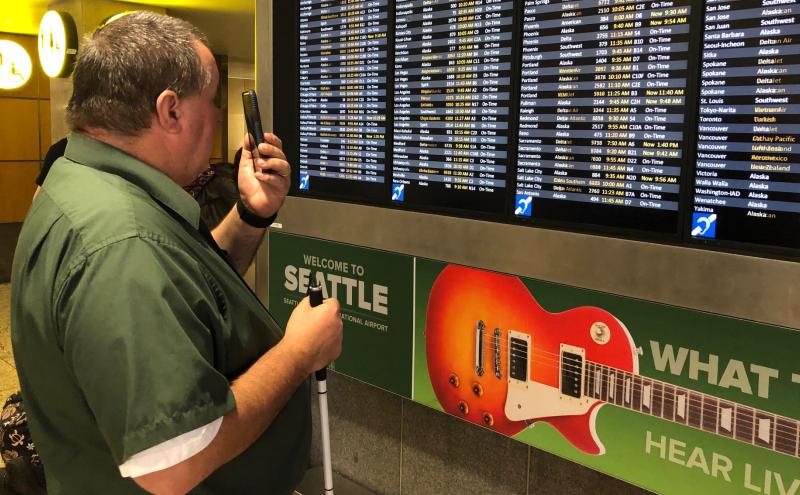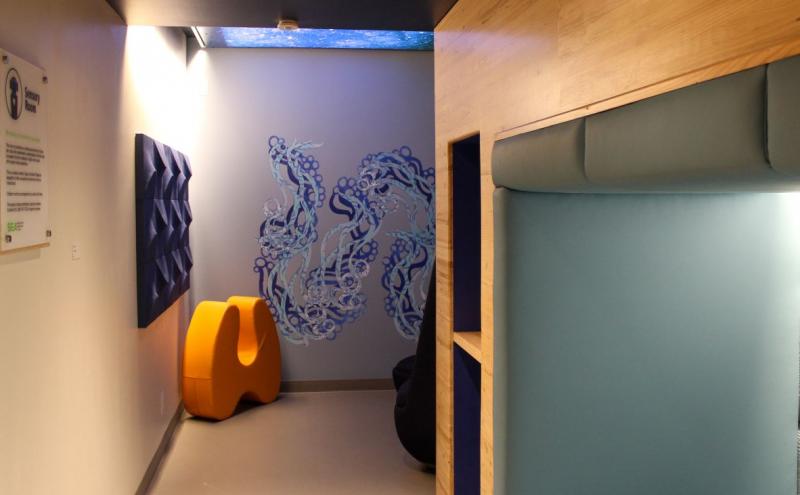
Standing in line at the airport, navigating through a crowded concourse to your gate, or taking a train can be stressful. During your journey, there’s so much to see and hear, including the sensory stimulus of restaurant signage and retail products, overhead messages, beeping carts, and the chatter of your fellow passengers. Travel can be tiring for most of us; but for passengers who have Autism, sensory processing diversity, or other developmental disabilities, this stimulation can be an overwhelming sensory experience that can cause exhaustion, increase the likelihood of a meltdown, or cause physical pain and headaches.
Today, on World Autism Awareness Day, we launch the new Sensory Room for travelers who need a quiet space in the airport. One in 54 children has been identified in the US with an Autism spectrum disorder (CDC Statistics, September 2019) and the Transportation Security Administration (TSA) has reported a 56% increase in the number of requests for assistance for passengers with Autism as of mid-year 2019.
Seattle-Tacoma International Airport (SEA) is working towards the goal of becoming the most accessible airport in the country. Another step on this journey is the brand new and specially-designed Sensory Room to provide an oasis for travelers who need a break or a space to recover. If you aren’t familiar with the term Sensory Room, it’s because there are only a handful of Sensory Rooms in U.S. airports. Sensory Rooms are specially designed to provide a space where passengers can escape and decompress from a stressful travel experience to calm their bodies through the interaction with carefully selected finishes, lighting, and furniture that reflect the best things about the Pacific Northwest.
The room was specially designed for passengers with Autism and other sensory processing disorder but can be used by passengers of any age seeking a respite from the sights and sounds of the terminal. The SEA Airport room has many intentional features that create a soothing environment:
a starlit sky,
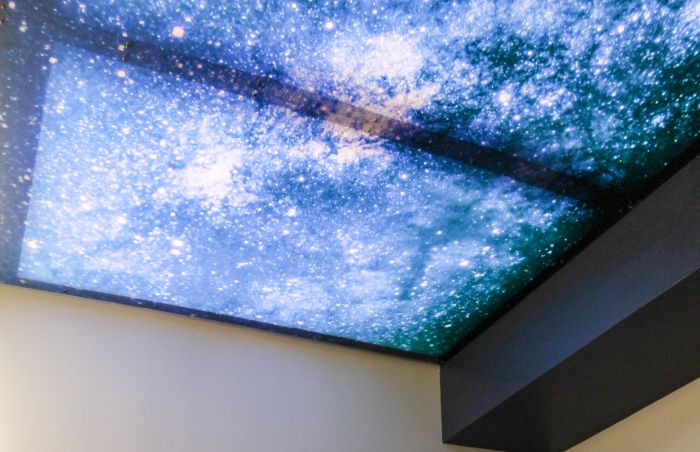
A seating nook to curl up in,
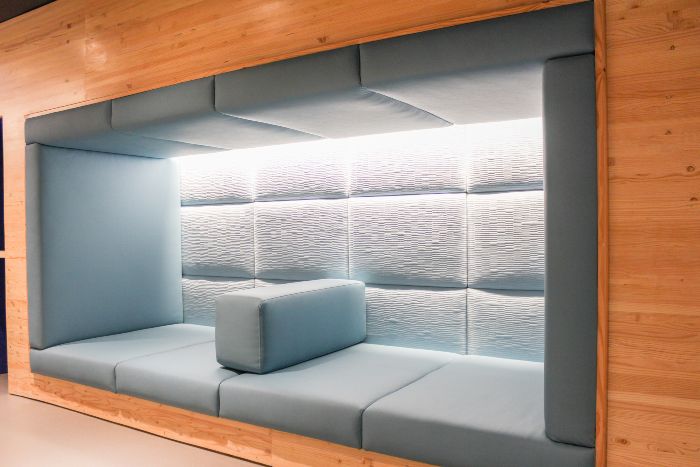
a rocking chair, a chair that provides tactile comfort like a hug, and large sitting pillows that can be rearranged

artwork from Tacoma-based artist June Sekiguchi titled Serpentine Serenity. An immersive experience implying movement, free flowing water patterns in shades of blue offer a calming focus for the viewer. For Sekiguchi, water is essential sustenance and a purifier cleansing the soul.
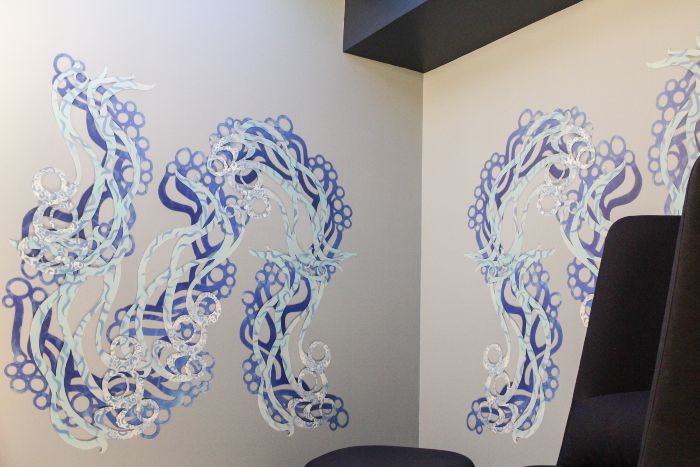
and acoustic panels to dampen sound inside and outside the room.
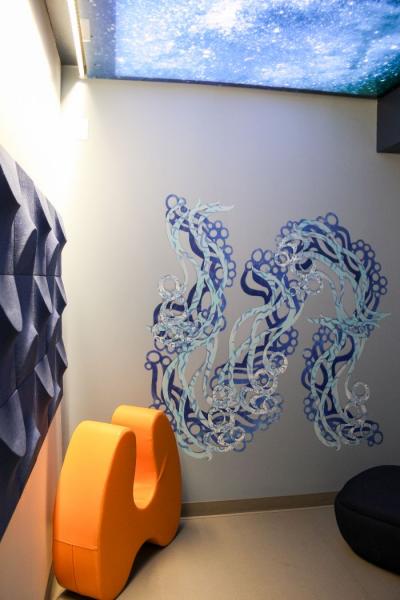
How do I find the room?
The Sensory room is located after security on the A Train Station level, in the hall near the elevator. The easiest way to get there is to take the elevator across from the Starbucks near Gate A3, from the concourse level to the Train level. The Sensory Room and Interfaith Prayer and Meditation Room are a short walk down the hall towards the train platform.
Outside the sensory room is a temporary art exhibit that further showcases the work of artists June Sekiguchi and Weston Lambert, who have permanent works within the Meditation and Interfaith Prayer and Sensory Room. The new art cases will feature rotating temporary works of local artists and currently include a range of three-dimensional pieces by both artists.

After going through the security checkpoint, look for this wayfinding symbol that was developed specifically for the Sensory Room based on research of existing symbols used by other organizations. The symbol was reviewed by internal and external stakeholders including Open Doors Organization, The Arc of King County, and Seattle Therapy Network therapists. It was chosen because it reflected love and inclusivity and was received with overwhelming response and support by the stakeholders.
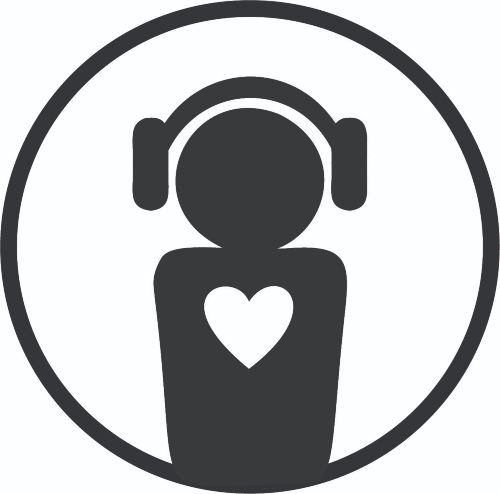
How was the room developed?
The Port of Seattle worked with multiple community stakeholders to design the space. To gather input during the design process, the Port reached out to other airports with Sensory Rooms, met with parents of children with autism, and consulted with occupational therapists who specialize in these conditions.
Advocates for people with sensory differences weigh in on the value of this room to the community:
The Port of Seattle, through this project, is expanding access for all individuals to have a positive interaction with the airport and feel included and valued as travelers. A sensory room creates an opportunity to help neurodiverse individuals to feel a sense of belonging in this public space. It would offer them (and their families, companions, and caregivers) the ability to regulate and manage the demands of air travel, calm their sensory systems between flights, and have a quiet, sensory friendly way to find respite in an environment that is well known for being loud, busy, unpredictable, and visually overwhelming.
As an occupational therapist with over 20 years of experience in supporting individuals with sensory processing challenges and with advanced certification in Sensory Integration, I am beyond excited to see SEA Airport become a more welcoming and neurodiverse space. When everyone is included in design, it decreases barriers and improves the ability for all people to live their lives to the fullest!
— Carey Goldenberg MS, OTR/L, SIPT Certified, CEO, Seattle Therapy Network
The new Sensory Room at the airport will make a huge difference in the lives of those travelling with autism, dementia, and other sensory processing and anxiety disorders, their families and all air travelers. The space is designed to allow individuals who have become over-stimulated by the environment the chance to calm down and decompress before boarding a flight. Having a quiet space with soothing light, calming colors and an opportunity for proprioceptive input (interactive pushing, pulling, lifting) will relax the over-stimulated nervous system, allowing that individual the opportunity to reset prior to the rest of their trip. This room will be utilized by all ages, as sensory processing disorders can occur across the lifespan. Parents and travel companions could plan their trip with this room in mind, as a destination safe spot prior to departure and on their return from their destination. Airport, airline and TSA employees would now have a calming place they could share with passengers, to assist those in need of respite. The Sensory Room at Seattle- Tacoma International Airport is a welcome addition to all and we cannot wait to share this with our families.
— Stacia Gallaher Irons; Board of Directors, The Arc of King County; Program manager, Wings for Autism Program
The Sensory Room is another example of how SEA Airport supports the diversity of passengers traveling through the airport every year. Other resources for passengers with Autism include:
Sunflower Lanyard Program
SEA was the first airport in the U.S. to launch this program. Sunflower lanyards are a discreet way to let airport staff know that you or someone in your family has a hidden disability and might need additional assistance. Travelers or their companions can pick up a complimentary sunflower lanyard at the main information desk between checkpoint 3 and checkpoint 4 (near the Starbucks and US Bank). Or ask any Pathfinder wearing green.
SEA Airport Social Story and Resource Guide for Air Travel during COVID-19
Working with The Arc of King County and the Washington Autism Alliance, the SEA Airport team produced a social story that explains the travel process at SEA, specifically addressing expectations during COVID-19.
- Download the Social Story PDF to review before and during the journey.
Wings for Autism® program
The Arc of King County's program helps individuals with an Autism spectrum disorder, their families, and aviation professionals to rehearse the travel experience at SEA Airport in advance. It’s designed to alleviate the stress and confusion of traveling by air and provides a chance to practice navigating through the airport, collecting boarding passes and entering security, and boarding the plane. The program also provides essential training for airport, airline, and Transportation Security Administration professionals.
Note: This program is temporarily on hold due to COVID-19, but we look forward to restarting the program when conditions allow.
- Read Commissioner Calkins’ blog
- Learn more at The Arc of King County
At SEA, we know that air travel can be overwhelming and hope this new room (and many other accessibility programs) help all travelers elevate their airport experience every day.
Other resources:
Read these additional resources on accessibility at SEA Airport:


